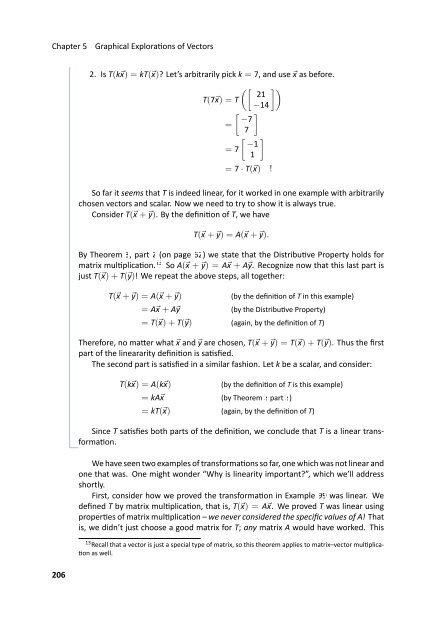Fundamentals of Matrix Algebra, 2011a
Fundamentals of Matrix Algebra, 2011a
Fundamentals of Matrix Algebra, 2011a
Create successful ePaper yourself
Turn your PDF publications into a flip-book with our unique Google optimized e-Paper software.
Chapter 5<br />
Graphical Exploraons <strong>of</strong> Vectors<br />
2. Is T(k⃗x) = kT(⃗x)? Let’s arbitrarily pick k = 7, and use ⃗x as before.<br />
([ ]) 21<br />
T(7⃗x) = T<br />
−14<br />
[ ] −7<br />
=<br />
7<br />
[ ] −1<br />
= 7<br />
1<br />
= 7 · T(⃗x) !<br />
So far it seems that T is indeed linear, for it worked in one example with arbitrarily<br />
chosen vectors and scalar. Now we need to try to show it is always true.<br />
Consider T(⃗x +⃗y). By the definion <strong>of</strong> T, we have<br />
T(⃗x +⃗y) = A(⃗x +⃗y).<br />
By Theorem 3, part 2 (on page 62) we state that the Distribuve Property holds for<br />
matrix mulplicaon. 13 So A(⃗x + ⃗y) = A⃗x + A⃗y. Recognize now that this last part is<br />
just T(⃗x) + T(⃗y)! We repeat the above steps, all together:<br />
T(⃗x +⃗y) = A(⃗x +⃗y)<br />
(by the definion <strong>of</strong> T in this example)<br />
= A⃗x + A⃗y (by the Distribuve Property)<br />
= T(⃗x) + T(⃗y) (again, by the definion <strong>of</strong> T)<br />
Therefore, no maer what ⃗x and ⃗y are chosen, T(⃗x + ⃗y) = T(⃗x) + T(⃗y). Thus the first<br />
part <strong>of</strong> the lineararity definion is sasfied.<br />
The second part is sasfied in a similar fashion. Let k be a scalar, and consider:<br />
T(k⃗x) = A(k⃗x)<br />
(by the definion <strong>of</strong> T is this example)<br />
= kA⃗x (by Theorem 3 part 3)<br />
= kT(⃗x) (again, by the definion <strong>of</strong> T)<br />
Since T sasfies both parts <strong>of</strong> the definion, we conclude that T is a linear transformaon.<br />
.<br />
We have seen two examples <strong>of</strong> transformaons so far, one which was not linear and<br />
one that was. One might wonder “Why is linearity important?”, which we’ll address<br />
shortly.<br />
First, consider how we proved the transformaon in Example 99 was linear. We<br />
defined T by matrix mulplicaon, that is, T(⃗x) = A⃗x. We proved T was linear using<br />
properes <strong>of</strong> matrix mulplicaon – we never considered the specific values <strong>of</strong> A! That<br />
is, we didn’t just choose a good matrix for T; any matrix A would have worked. This<br />
13 Recall that a vector is just a special type <strong>of</strong> matrix, so this theorem applies to matrix–vector mulplica-<br />
on as well.<br />
206

















